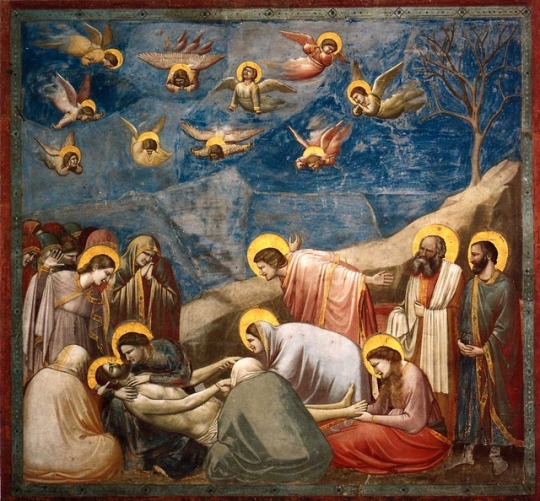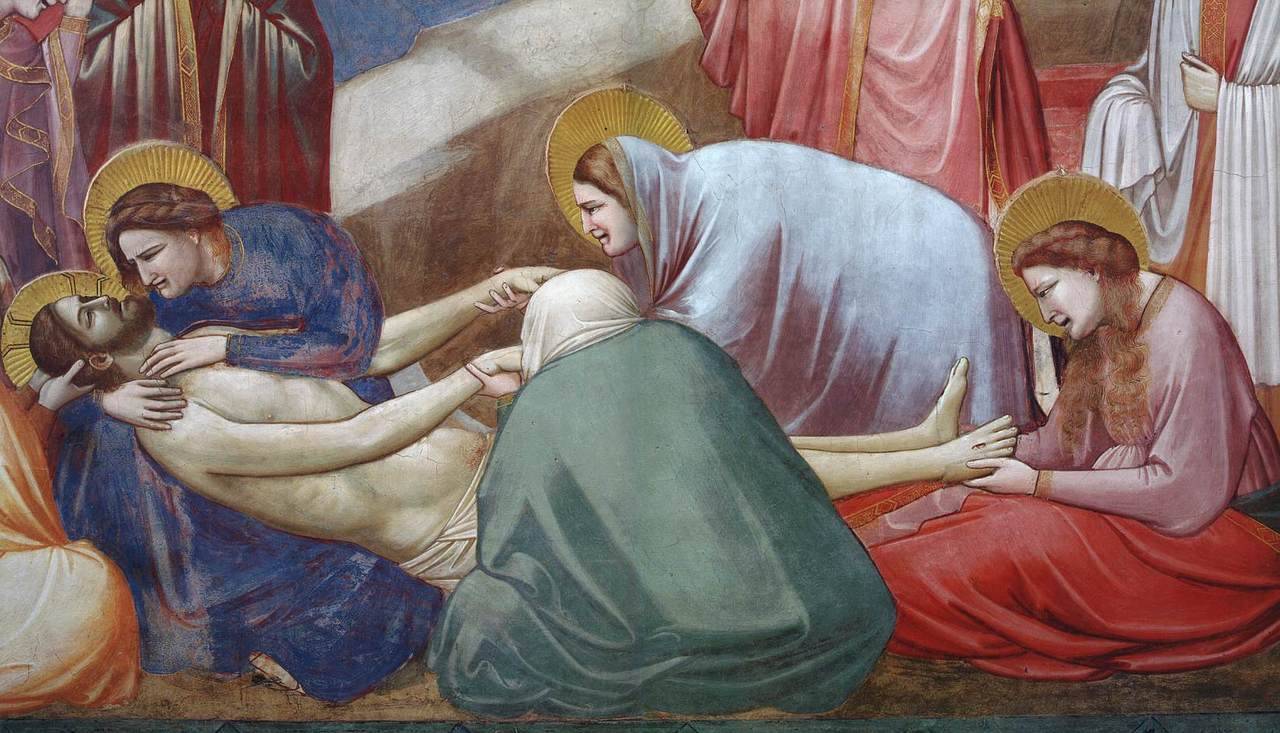Looking at a Masterpiece:
The Lamentation of Christ

This fresco by Giotto di Bondone
Scrovegni Chapel in Padua c.1305
Scrovegni Chapel in Padua c.1305
Giotto's style heralded a new development in the art of the late
Middle Ages. The sacred art of the Byzantine period which preceded it
had a solemn and holy beauty of its own, but was two-dimensional,
immobile, and largely symbolic. Giotto initiated a more natural,
emotionally expressive human style, which was — it seems — inspired by
the spirituality of St. Francis of Assisi, Giotto being a third order
Franciscan himself.
St. Francis brought a new focus on, and a richer perception of, the
great mystery of the Incarnation - God becoming flesh - into the
spiritual treasure house of the Church. This had a huge impact on
artistic expression, notably on the vision of Giotto.
Basically, it made the divine more accessible to us humans, and transformed the human through the touch of the divine. Humanity with all its varying emotions of joy and sorrow can be quickened by God's grace, and in communion with the living God.
Consequently these human emotions, purified through grace of sinful inclinations, are transformed, acquiring an unheard of depth and sublimity. Thus this great art challenges us to reach to another level. We start to see everything in the light of Christ.

Basically, it made the divine more accessible to us humans, and transformed the human through the touch of the divine. Humanity with all its varying emotions of joy and sorrow can be quickened by God's grace, and in communion with the living God.
Consequently these human emotions, purified through grace of sinful inclinations, are transformed, acquiring an unheard of depth and sublimity. Thus this great art challenges us to reach to another level. We start to see everything in the light of Christ.

- Why, if Christ has risen, should we enter so deeply into mourning over His passion and death?
- Why does St. Francis, and Giotto in his
footsteps, contemplate it so profoundly?
First, because the
Resurrection, and the great joy it brings, makes no sense without it.
We must live through all the stages.
Second, because "the clearest proof of the reliability of Christ's love is to be found in his dying for our sake . . . in that hour the depth and breadth of God's love shone forth . . ." and "love is always lived out in body and spirit."
In many lamentation paintings the predominant note is sorrow, for instance in a truly moving one by Rogier van der Weyden.
Though this Giotto fresco depicts the disciples' deep sorrow over Christ's death, their aching pain over parting from Jesus, it is not desolate. Its spirit is not so much primarily of sorrow.
Rather its surpassing theme is love, the overwhelming love of Jesus, His laying down His life for the disciples, and their love for Him. "God loved us first (cf. Jn 4:10) that we might love Him. This is the explanation of it all."
Giotto's frugal style, while being passionate, is unrestrained and
flowing. He contemplates this boundless love and draws us into it.
Who
is this man who loves us even unto death and who has this power to draw
all things to Himself? (Jn 12:32) It is the slain Lamb, Jesus Christ,
Son of God, Savior.
Even the artist's masterful composition expresses this: all lines, the rocky ledge, the figures, all converge and tend toward the Sacred Head of Jesus.
All eyes, Mary's above all in their poignancy, Mary Magdalen's at His feet, especially St. John with his arms thrown open, the intensity of love in that gesture, and the other disciples, all evidence profound love for the Beloved, coming from their burning hearts, and their desire to share in His suffering. Nothing else matters but this pierced Jesus in His sacred humanity.
As a result their and our hearts are transfixed. "Thou hast wounded my heart" (Song 4:9). His Love engenders passionate love. "Deep calls upon deep." (Ps 42:7) Our sins have wounded Him. "Those wounds were to be the doors to heaven — even for those who had made them . . . He loved us to the utmost limit. St. John finds only these words: 'He loved them to the end.' (Jn 13:1)"
The angels in heaven weep over Christ's suffering for our sins. It is said that angels do not have dry hearts. Their love vibrates with our joy and grief; how much more with Christ's passion.
Giotto di Bondone (c. 1266-1337)
The Lamentation (1305)


https://www.catholiceducation.org/en/culture/art/looking-at-a-masterpiece-the-lamentation-of-christ.html
https://art-nyc.tumblr.com/post/184298130480/giotto-di-bondone-lamentation-the-mourning-of
https://art-nyc.tumblr.com/post/184298130480/giotto-di-bondone-lamentation-the-mourning-of




No comments:
Post a Comment